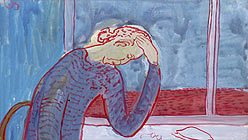I first saw Charlotte Salomon’s work at the Royal Academy in London in 1998. This exhibition and the subsequent tour were the beginning of a deeper recognition of Salomon’s legacy of around 1,300 notebook-size gouaches, 769 of which form the astounding autobiographical operetta Life? or Theater? (1940–42). Since then, her work has been thoroughly documented and analyzed as both a historical and personal record and a significant artistic achievement. Yet it remains first and foremost a unique, partly fictionalized visual journal of sorts, and I was looking forward to deepening my acquaintance with it at the Contemporary Jewish Museum (CJM).
Unfortunately, however, the rather strange exhibition design at CJM, which, viewed generously, could be understood as an attempt to break up the narrative into digestible segments, made a closer encounter difficult. It is partly the wealth of images in their uninterrupted flow and the complexity of the many-sided narrative that make the work the magnum opus it is, and this abridged version of almost one-third (278 gouaches) of the total oeuvre cannot do it full justice. As seen at the CJM, the installation perhaps gives us a sense of Salomon’s life as a young Jewish woman and artist, at least offering a familiar type of fragmentary, bullet-pointed portrayal, but it does not reveal the scope of her artistic achievement nor of the times in which she worked.
And yet, Life? or Theater? does not fail to move, engage, or provoke the second time around, and neither does the story of its genesis or creator. Made in just under eighteen months by a young woman reeling from the revelation of her maternal family’s history of depression and suicide and seeking a way out of the madness she feared would engulf her, the work represents its protagonist’s intent to “create a story so as not to lose my mind.” Catalyzed at the onset of World War II and during the height of the Holocaust years when the world itself seemed to have gone mad, the frenetic artistic activity that resulted in Life? or Theater? embodies not only Salomon’s race against insanity but also her sense of impending doom. Unfortunately, the latter fear was borne out by the artist’s arrest while in exile in the South of France and by her subsequent execution at Auschwitz in 1943.
Salomon’s molding of a portion of her visual diary into a musical drama, done to underscore the fictionalization and diffuse the horror of her life and times, is indicated by the work’s subtitle, “Ein Singspiel,” and structure. No doubt informed by her stepmother’s successful career as an opera singer, the work overflows with transcribed arias, folk, and popular songs of the time. It is structured in three parts, consisting of a prelude, a second act, and an epilogue. The prelude is devoted primarily to charmingly detailed scenes from her protagonist Charlotte Kahn’s childhood; the main part to Alfred Wolfsohn, her stepmother’s voice coach (and apparently Salomon’s first love), and Charlotte’s discovery of his ideas about art and the soul; and the epilogue concerns Charlotte’s life on the Côte d’Azur. The characters are partly renamed; Salomon’s father, the surgeon Alfred Salomon, appears as Alfred Kahn, and her stepmother Paula Lindberg

Untitled from Life? or Theatre?, 1940-1942; Courtesy of the Jewish Historical Museum, Amsterdam. Copyright Charlotte Salomon Foundation.
as Paulina Bimbam. This allows Salomon enough distance to weave the personal narrative of a young girl striving to find her voice as an artist with a larger social narrative. The title indicates the exercise of a meditation about the human condition, as more pessimistically evaluated by Jacques in Shakespeare’s As You Like It: “All the world’s a stage, and all the men and women merely players.” Salomon never answers the question, “Life? Or theater?” But when entrusting this work to a friend shortly before her arrest, the author allegedly told him, “Keep this safe. It’s my entire life.” As has been well documented, the primary condition of exile is isolation. There were countless manuscripts produced, countless poems written and pictures made during those years by exiles, and also by internees, all over Europe and in the United States. All of these activities implied an awareness of, and a desire for, a potential audience, albeit not of contemporaries. These works were made to be seen someday.


